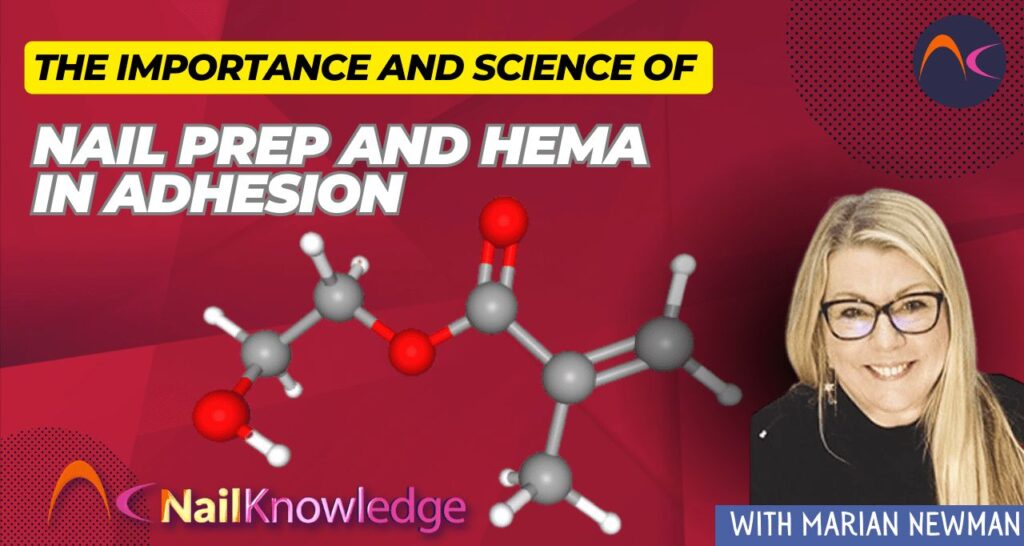El papel del HEMA en la mejora de la adherencia del recubrimiento ungueal
Most nail pros now understand the function of HEMA.
It is a monomer that enhances the adhesion of a coating on the nail plate. Higher percentages of HEMA allow for maximum adhesion with little nail prep. When HEMA is at a lower level then a better level of nail prep is needed.
Those who are rebranding from a high HEMA level to a lower level are often surprised that they have incidences of lifting. This is almost always due to the lack of accurate nail prep.
HEMA adheres very well to the keratin in the nail plate cells. Nail prep can be minimal for a high HEMA product. It will adhere well and stay put for several weeks.
However, higher percentages of HEMA can trigger allergic reactions, as a significant portion of the monomer might not undergo complete curing. This partial curing could result in the leaching of HEMA, potentially leading to various issues.
Mejora de la preparación de las uñas durante la transición a un menor porcentaje de HEMA
Cuando se cambia a un HEMA % inferior, es esencial prestar más atención a la preparación de las uñas.
¿Por qué?
The cells of the nail plate are non-living and are mostly keratin and a small amount of other cell contents. Non-living skin cells, that is the cuticle on the nail plate have less keratin content and more of the additional cell contents. It is more like the dry skin that we see on legs, for example. It will easily slough off, but the keratin of the nail plate cells is connected to other nail plate cells and is designed to stay put!
Preparación completa de la placa ungueal
La preparación correcta de la placa ungueal consiste en una serie de pasos. Estos pasos deberían durar entre un tercio y la mitad de todo el servicio. Llevar a cabo una correcta preparación de las uñas requiere todo este tiempo.
En primer lugar, deben seguirse las instrucciones del fabricante.
El proceso
- some suggest using a cuticle remover. This is usually a sodium hydroxide based product that softens the non-living skin cells of the cuticle
- otros sugieren una eliminación totalmente en seco de la cutícula
- dejar cualquier rastro de cutícula en la placa de la uña provocará el levantamiento, ya que el revestimiento no se adherirá a ella
- cuticle on the nail can be much further up the nail than many realise. It can be over ½ way up the nail
- utilizar una buena herramienta para cutículas te permitirá sentir la cutícula. Es más blanda que la lámina ungueal
- every last trace must be removed by using gentle movements with a cuticle tool. If the cuticle ends up as a ‘frill’ at the base of the nail this is what must be cut off! NOT the living proximal nail fold
- también se encuentra mucha cutícula a los lados de la lámina ungueal
- después de esto muchas marcas requieren la eliminación del brillo. Esto debería ser sólo el brillo y un bloque blanco debería ser suficiente. Todo lo que sea más fuerte diluirá la placa de la uña y causará problemas en el futuro.
- una vez que esté absolutamente seguro de que se ha eliminado todo rastro de cutícula, se debe proceder a la limpieza de la lámina ungueal
- la placa de la uña siempre tiene un nivel de aceites y humedad en su superficie. Esto creará una barrera para el revestimiento, por lo que debe eliminarse con cuidado.
- usually a combination of acetone (a solvent) and IPA (an alcohol) will make sure this is done efficiently
- care must be taken to include the side of the nail plate and right up to the proximal nail fold so every part of the nail plate is clean and oil-free
- aquellos entonces los fabricantes que tienen un problema de agarre en los recubrimientos, esto debe hacerse un clavo a la vez y luego aplicar el recubrimiento. Los aceites naturales muy pronto serán reemplazados
- deben seguirse las recomendaciones de los fabricantes. Algunos recomiendan una ayuda adicional para la adhesión y el uso de una imprimación para asegurarse de que la queratina está preparada para aceptar el revestimiento.
- if all these steps are done efficiently, it will be almost ½ of the whole service and it is worth it as there will be little chance of a service breakdown
- Muchos sugieren que los medicamentos pueden afectar a la adherencia. Esto no es necesariamente cierto, ya que la superficie de la uña es la que crea la adherencia y si ésta es buena nada la afectará.
Muchas marcas necesitan esta preparación minuciosa y eficaz de las uñas, y cualquier cosa que no sea así provocará una avería en el servicio.
En conclusión
Si está acostumbrado a un alto contenido de HEMA y cambia a un contenido más bajo de HEMA, es absolutamente necesario que dedique más tiempo a la preparación de sus uñas. Nada menos será suficiente.
No deje de ver nuestra minilección sobre HEMA en la industria de las uñas


